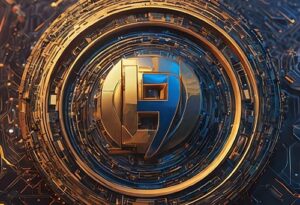NFT (non-fungible token) is a unique digital asset that operates on blockchain technology. Unlike cryptocurrencies, each NFT is one of a kind and cannot be replaced by another similar token.
NFTs address the issue of establishing ownership rights over digital objects, as information about the owner, the token, and all transactions is permanently recorded on the blockchain (for more details on blockchain technology, refer to our dedicated article). These records cannot be altered or deleted.
However, NFTs have faced criticism for their involvement in fraudulent schemes, speculative activities, and the negative environmental impact due to high energy consumption.
History of NFTs
 The development of the NFT concept began in 2012 with the emergence of projects like Colored Coins and Counterparty on the Bitcoin blockchain (for more information about Bitcoin, refer to our dedicated article). In 2016, the first NFT collection, Rare Pepes, appeared on the Counterparty platform.
The development of the NFT concept began in 2012 with the emergence of projects like Colored Coins and Counterparty on the Bitcoin blockchain (for more information about Bitcoin, refer to our dedicated article). In 2016, the first NFT collection, Rare Pepes, appeared on the Counterparty platform.
A new era for NFTs began in 2016 – 2017 with the transition to the Ethereum blockchain, which introduced the term «non-fungible token» and simplified the process of creating them.
The NFT market experienced a sharp growth in 2020, and by 2021 it had become one of the most promising areas for blockchain application. Major companies such as Hermes, Tiffany, Dolce & Gabbana, and the NBA launched their own NFT collections.
However, by mid-2022, the NFT market began to decline, with sales in May decreasing by 92% compared to autumn 2021. By mid-2023, 95% of NFT collections had lost all value. Despite this, some experts predict that by 2030 the NFT market could reach a volume of $240 billion.
The most expensive NFT in history is a digital project called The Merge, created by the artist known as Pak. In December 2023, this piece was sold for $91.8 million through the NFT platform Nifty Gateway.
How to create an NFT
Creating an NFT typically involves interacting with smart contracts, which are available on various specialised platforms, such as auction sites or marketplaces like Opensea, SuperRare, and Rarible. Simply put, these platforms offer a function to upload files (for example, images), resulting in the creation of a record with a link to the cryptographic hash of the digital file, which represents the NFT. Most platforms charge a fee for this service. The generated tokens can then be stored in your account, in a digital wallet, or sold to other users.
Those looking to profit from NFTs often create entire collections of tokens, consisting of hundreds or even thousands of items. The most well-known collection is CryptoPunks, comprising 10,000 unique images, each different from the others.
Use of NFTs
A cryptographic NFT token can be linked to both fully digital and real, physical objects. The most popular areas of NFT application include:
- collecting digital art and other items;
- computer games and metaverses;
- music;
- fashion and luxury goods;
- finance, and more.
NFTs can be bought, sold, and exchanged either directly between individuals or through specialised platforms (marketplaces). The value of such tokens can be fixed or determined through auction sales on the platform.
It is noteworthy that NFTs (non-fungible tokens) are not currently regulated under the MiCA (Markets in Crypto-Assets) framework in the European Union (for more information about MiCA, refer to our dedicated article). However, this may change in the future if legislation is updated to accommodate the sector’s growth.
 The development of the NFT concept began in 2012 with the emergence of projects like Colored Coins and Counterparty on the Bitcoin blockchain (for more information about Bitcoin, refer to our dedicated
The development of the NFT concept began in 2012 with the emergence of projects like Colored Coins and Counterparty on the Bitcoin blockchain (for more information about Bitcoin, refer to our dedicated